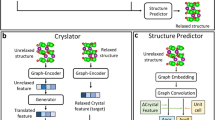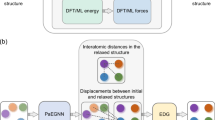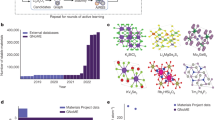Abstract
Elasticity is ubiquitous and produces a spontaneously reversible response to applied stress1. Despite the utility and importance of this property in regard to scientific and engineering applications, the atomic-scale location of the force that returns an object to its original shape remains elusive in molecular crystals. Here we use a series of density functional theory calculations to locate precisely where the energy is stored when single crystals of three molecular materials are placed under elastic stress. We show for each material that different intermolecular interactions are responsible for the restoring force under both expansive and compressive strain. These findings provide insight into the elastic behaviour of crystalline materials that is needed for more efficient design of flexible technologies and future smart devices.
This is a preview of subscription content, access via your institution
Access options
Access Nature and 54 other Nature Portfolio journals
Get Nature+, our best-value online-access subscription
$32.99 / 30 days
cancel any time
Subscribe to this journal
Receive 12 print issues and online access
$259.00 per year
only $21.58 per issue
Buy this article
- Purchase on SpringerLink
- Instant access to full article PDF
Prices may be subject to local taxes which are calculated during checkout



Similar content being viewed by others
Data availability
The results of calculations are provided as Supplementary Data 1–4. Source data are provided with this paper.
Code availability
The Python scripts used to produce the extrapolated atomic coordinates as described in Supplementary Information are available as Supplementary Code 1 or from the authors.
References
Callister, W. D. & Rethwisch, D. G. Materials Science and Engineering: An Introduction 10th edn (Wiley, 2018).
Chaudhuri, O. & Mooney, D. J. Anchoring cell-fate cues. Nat. Mater. 11, 568–569 (2012).
Diz-Muñoz, A., Fletcher, D. A. & Weiner, O. D. Use the force: membrane tension as an organizer of cell shape and motility. Trends Cell Biol. 23, 47–53 (2013).
Liang, X., Fu, H. & Crosby, A. J. Phase-transforming metamaterial with magnetic interactions. Proc. Natl Acad. Sci. USA 119, e2118161119 (2022).
Wu, Y., Ma, Y., Zheng, H. & Ramakrishna, S. Piezoelectric materials for flexible and wearable electronics: a review. Mater. Des. 211, 110164 (2021).
Roberts, T. J. & Azizi, E. Flexible mechanisms: the diverse roles of biological springs in vertebrate movement. J. Exp. Biol. 214, 353–361 (2011).
Shabahang, S., Clouser, F., Shabahang, F. & Yun, S.-H. Single-mode, 700%-stretchable, elastic optical fibers made of thermoplastic elastomers. Adv. Opt. Mater. 9, 2100270 (2021).
Vakhshouri, B. Modulus of elasticity of concrete in design codes and empirical models: analytical study. Pract. Period. Struct. Des. Constr. 23, 04018022 (2018).
Zhu, Z. et al. Hominin occupation of the Chinese Loess Plateau since about 2.1 million years ago. Nature 559, 608–612 (2018).
Trealor, L. R. G. The Physics of Rubber Elasticity (Oxford Univ. Press, 1975).
Bucciarelli, L. L. Engineering Mechanics for Structures (Dover Publications, 2009).
Sharda, S. C. & Tschoegl, N. W. The elastic restoring force in rubbers. Macromolecules 9, 910–917 (1976).
Kitaigorodsky, A. I. Molecular Crystals and Molecules (Academic, 1973).
Joel, N. & Wooster, W. A. Theories of crystal elasticity. Nature 180, 430–431 (1957).
Viswanathan, K. S. The theory of elasticity and of wave-propagation in crystals from the atomistic standpoint. Proc. Ind. Acad. Sci. 39, 196–213 (1954).
Raman, C. V. & Viswanathan, K. S. The elastic behaviour of isotropic solids. Proc. Ind. Acad. Sci. 42, 1–9 (1955).
Thompson, A. J. et al. Elastically flexible molecular crystals. Chem. Soc. Rev. 50, 11725–11740 (2021).
Thompson, A. J., Price, J. R., McMurtrie, J. & Clegg, J. K. The mechanism of bending in co-crystals of caffeine and 4-chloro-3-nitrobenzoic acid. Nat. Commun. 12, 5983 (2021).
Lu, Z. et al. Optical waveguiding organic single crystals exhibiting physical and chemical bending features. Angew. Chem. Int. Ed. Engl. 59, 4299–4303 (2020).
Kenny, E. P., Jacko, A. C. & Powell, B. J. Towards mechanomagnetics in elastic crystals: insights from [Cu(acac)(2)]. Angew. Chem. Int. Ed. Engl. 58, 15082–15088 (2019).
Annadhasan, M. et al. Mechano-photonics: flexible single-crystal organic waveguides and circuits. Angew. Chem. Int. Ed. Engl. 59, 13852–13858 (2020).
Ravi, J. et al. Geometrically reconfigurable, 2D, all-organic photonic integrated circuits made from two mechanically and optically dissimilar crystals. Adv. Funct. Mater. 31, 2105415 (2021).
Lan, L. et al. Hybrid elastic organic crystals that respond to aerial humidity. Angew. Chem. Int. Ed. Engl. 61, e202200196 (2022).
Di, Q. et al. Fluorescence-based thermal sensing with elastic organic crystals. Nat. Commun. 13, 5280 (2022).
Worthy, A. et al. Atomic resolution of structural changes in elastic crystals of copper(II) acetylacetonate. Nat. Chem. 10, 65–69 (2018).
Brock, A. J. et al. Elastically flexible crystals have disparate mechanisms of molecular movement induced by strain and heat. Angew. Chem. Int. Ed. Engl. 57, 11325–11328 (2018).
CrystalExplorer17 v. 17.5 (Univ. of Western Australia, 2017).
Mackenzie, C. F., Spackman, P. R., Jayatilaka, D. & Spackman, M. A. CrystalExplorer model energies and energy frameworks: extension to metal coordination compounds, organic salts, solvates and open-shell systems. IUCrJ. 4, 575–587 (2017).
Turner, M. J., Thomas, S. P., Shi, M. W., Jayatilaka, D. & Spackman, M. A. Energy frameworks: insights into interaction anisotropy and the mechanical properties of molecular crystals. Chem. Commun. 51, 3735–3738 (2015).
Jensen, F. An atomic counterpoise method of estimating inter- and intrmolecular basis set superposition errors. J. Chem. Theory Comput. 6, 100–106 (2010).
Chai, J.-D. & Head-Gordon, M. Long-range corrected hybrid density functionals with damped atom-atom dispersion corrections. Phys. Chem. Chem. Phys. 10, 6615–6620 (2008).
Kresse, G. & Furthmuler, J. Efficient iterative schemes for ab initio total-energy calculations using a plane-wave basis set. Phys. Rev. B 54, 11169–11186 (1996).
Becke, A. D. Density-functional thermochemistry. III. The role of exact exchange. J. Chem. Phys. 98, 5648–5652 (1993).
Stephens, P. J., Devlin, F. J., Chabalowski, C. F. & Frisch, M. J. Ab initio calculation of vibrational absorption and circular dichroism spectra using density functional force fields. J. Phys. Chem. 98, 11623–11627 (1994).
Grimme, S., Ehrlich, S. & Goerigk, L. Effect of the damping function in dispersion corrected density functional theory. J. Comput. Chem. 32, 1456–1465 (2011).
Thompson, A. J., Powell, J. A., Melville, J. N., McMurtrie, J. C. & Clegg, J. K. Crystals of aliphatic derivatives of [Cu(acac)2] have distinct atomic-scale mechanisms of bending. Small 19, 2207431 (2023).
Lacroix, C., Mila, F. & Mendels, P. (eds). Introduction to Frustrated Magnetism: Materials, Experiments, Theory (Springer, 2011).
Paez-Espejo, M., Sy, M. & Boukheddaden, K. Elastic frustration causing two-step and multistep transitions in spin-crossover solids: emergence of complex antiferroelastic structures. J. Am. Chem. Soc. 138, 3202–3210 (2016).
Cruddas, J. & Powell, B. J. Spin-state ice in elastically frustrated spin-crossover materials. J. Am. Chem. Soc. 141, 19790–19799 (2019).
Maul, J., Ongari, D., Moosavi, S. M., Smit, B. & Erba, A. Thermoelasticity of flexible organic crystals from quasi-harmonic lattice dynamics: the case of copper(II) acetylacetonate. J. Phys. Chem. Lett. 11, 8543–8548 (2020).
Devarapalli, R. et al. Remarkably distinct mechanical flexibility in three structurally similar semiconducting organic crystals studied by nanoindentation and molecular dynamics. Chem. Mater. 31, 1391–1402 (2019).
Bhandary, S. et al. The mechanism of bending in a plastically flexible crystal. Chem. Commun. 56, 12841–12844 (2020).
Sheldrick, G. M. Crystal structure refinement with SHELXL. Acta Cryst. C71, 3–8 (2015).
Krishnan, R., Blinkley, J. S., Seeger, R. & Pople, J. A. Self-consistent molecular orbital methods. XX. A basis set for correlated wave functions. J. Chem. Phys. 72, 650–654 (1980).
Clark, T., Chandrasekhar, J., Spitznagel, G. W. & Schleyer, P. V. R. Efficient diffuse function-augmented basis sets for anion calculations. III. The 3-21 + G basis set for first-row elements, Li-F. J. Comput. Chem. 4, 294–301 (1983).
Hay, P. J. & Wadt, W. R. Ab initio effective core potentials for molecular calculations. Potentials for K to Au including the outermost core orbitals. J. Chem. Phys. 82, 299–310 (1985).
Gaussian 16, Revision B.01 (Gaussian, Inc., 2016).
GraphPad Prism, v.8.2.1 (GraphPad Software LLC, 2022).
Kresse, G. & Furthmüller, J. Efficiency of ab-initio total energy calculations for metals and semiconductors using a plane-wave basis set. Comput. Mater. Sci. 6, 15–50 (1996).
Acknowledgements
A.J.T. thanks AINSE Limited for providing financial assistance (PGRA Award). B.S.K.C. thanks the University of Queensland for Research Training Program financial support. The University of Queensland Research Computing Centre, Phoenix HPC service at the University of Adelaide and Pawsey Supercomputing Research Centre through the National Computational Merit Allocation Scheme are thanked for providing high-performance, computing resources. This research was supported by the Australian Government’s National Collaborative Research Infrastructure Strategy (NCRIS). B.J.P. thanks the Australian Research Council for financial support (DP181006201). J.D.E. is a recipient of an Australian Research Council Discovery Early Career Award (DE220100163). We thank A. Grosjean for providing input into the design of CrystalExplorer calculations, and for comments on an early version of the paper.
Author information
Authors and Affiliations
Contributions
B.S.K.C. performed DFT calculations for [CuL12]. A.J.T. wrote the Python scripts for structure extrapolation and undertook primary data analysis. E.P.K. performed VASP calculations. J.A.P. and A.J.T. performed CrystalExplorer calculations. J.D.E. performed calculations for [CuL22] and [CuL32]. B.J.P., M.A.S., J.C.M. and J.K.C. directed the research. All authors contributed to the analysis of results and writing of the paper.
Corresponding authors
Ethics declarations
Competing interests
The authors declare no competing interests.
Peer review
Peer review information
Nature Materials thanks Shotaro Hayashi, Satoshi Takamizawa and the other, anonymous, reviewer(s) for their contribution to the peer review of this work.
Additional information
Publisher’s note Springer Nature remains neutral with regard to jurisdictional claims in published maps and institutional affiliations.
Supplementary information
Supplementary Information
Computational methods, extrapolation methodology, calculated mechanical properties, calculation results, curve fitting and single-crystal cantilevers.
Supplementary Data 1
Electronic copy of Supplementary Table 1.
Supplementary Data 2
Electronic copy of Supplementary Table 2.
Supplementary Data 3
Results of calculations for complex of L1.
Supplementary Data 4
Results of calculations for complexes of L2 and L3.
Supplementary Code 1
Python extrapolation scripts.
Supplementary Video 1
Video of cantilever.
Supplementary Video 2
Video of cantilever.
Supplementary Video 3
Video of cantilever.
Supplementary Video 4
Video of cantilever.
Source data
Source Data Fig. 3
Data used for plotting and curve fitting in Fig. 3.
Rights and permissions
Springer Nature or its licensor (e.g. a society or other partner) holds exclusive rights to this article under a publishing agreement with the author(s) or other rightsholder(s); author self-archiving of the accepted manuscript version of this article is solely governed by the terms of such publishing agreement and applicable law.
About this article
Cite this article
Thompson, A.J., Chong, B.S.K., Kenny, E.P. et al. Origins of elasticity in molecular materials. Nat. Mater. 24, 356–360 (2025). https://doi.org/10.1038/s41563-025-02133-w
Received:
Accepted:
Published:
Issue date:
DOI: https://doi.org/10.1038/s41563-025-02133-w



